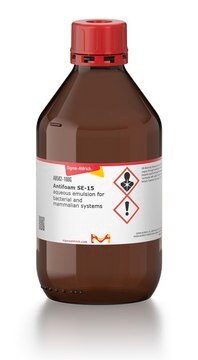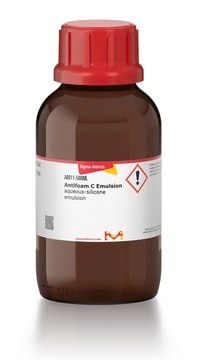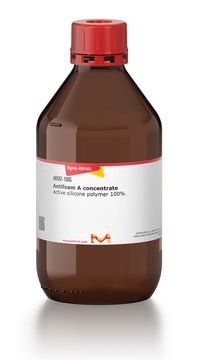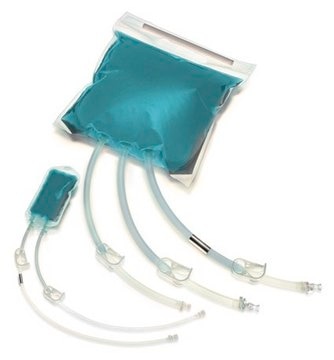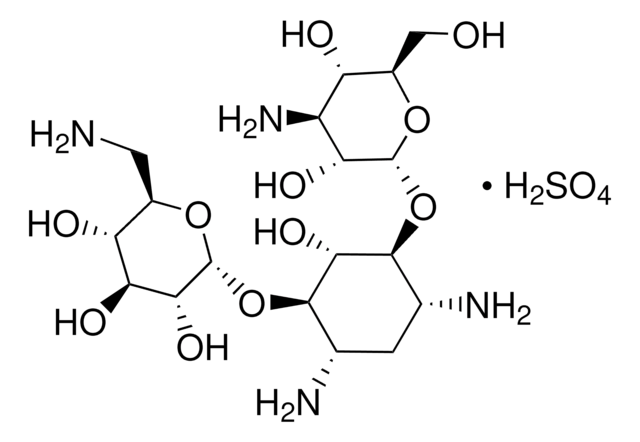A8311
Antifoam 204
aqueous emulsion for bacterial and mammalian systems
Synonym(s):
organic antifoam
Sign Into View Organizational & Contract Pricing
All Photos(1)
About This Item
Recommended Products
Quality Level
form
emulsion (aqueous)
concentration
100% (organic)
density
1.01 g/mL at 25 °C
application(s)
microbiology
storage temp.
room temp
suitability
(Mammalian (suspension))
bacteria (fermentation)
Looking for similar products? Visit Product Comparison Guide
Related Categories
General description
Antifoam 204 is an organic antifoam used to prevent or minimize foaming in both microbial fermentation systems and mammalian suspension cultures. Control of foaming minimizes damage to the cells, resulting in increased protein/antibody production.
Application
Suitable for preventing or minimizing foaming in microbial fermentation systems and mammalian suspension cultures.
Antifoam 204 has been used:
Antifoam 204 has been used:
- in the expression and purification of PUL (PLAP, Ufd3p, and Lub1p) domain
- in fed-batch fermentation
- to prevent bubble formation due in aeration in Luria Bertani (LB) culture medium for bacterial growth
- in the batch fermentation with mineral medium
Components
Antifoam 204 is a 100% active components and a mixture of non-silicone organic defoamers in a polyol dispersion.
Other Notes
Contains 100% active components and is a mixture of non-silicone organic defoamers in a polyol dispersion. Can be sterilized repeatedly.
Preparation Note
For use in microbiological media Sigma recommends a starting concentration of between 0.005% and 0.01%.
The optimal amount of antifoam required for various applications will need to be determined. Antifoam 204 is soluble in methanol, ethanol, toluene, xylene, perchloroethylene, and cold water at temperatures below 15 °C. It is insoluble in warm water and ethylene glycol.
The optimal amount of antifoam required for various applications will need to be determined. Antifoam 204 is soluble in methanol, ethanol, toluene, xylene, perchloroethylene, and cold water at temperatures below 15 °C. It is insoluble in warm water and ethylene glycol.
related product
Storage Class
10 - Combustible liquids
wgk_germany
WGK 3
flash_point_f
Not applicable
flash_point_c
Not applicable
ppe
Eyeshields, Gloves
Certificates of Analysis (COA)
Search for Certificates of Analysis (COA) by entering the products Lot/Batch Number. Lot and Batch Numbers can be found on a product’s label following the words ‘Lot’ or ‘Batch’.
Already Own This Product?
Find documentation for the products that you have recently purchased in the Document Library.
Customers Also Viewed
Yixin Yang et al.
Biomacromolecules, 11(1), 259-268 (2009-12-17)
Biobased omega-carboxy fatty acid monomers 1,18-cis-9-octadecenedioic, 1,22-cis-9-docosenedioic, and 1,18-cis-9,10-epoxy-octadecanedioic acids were synthesized in high conversion yields from oleic, erucic and epoxy stearic acids by whole-cell biotransformations catalyzed by C. tropicalis ATCC20962. Maximum volumetric yields in shake-flasks were 17.3, 14.2, and
Beth Junker
Biotechnology progress, 23(4), 767-784 (2007-06-15)
Key aspects of foaming and its mitigation in fermentation systems are presented. Foam properties and behavior, conditions that affect foaming, and consequences of foaming are discussed, followed by methods to detect and prevent foam, both without and with the use
Medium redesign for stable cultivation and high production of mevalonate by recombinant Methtylobacterium extorquens AM1 with mevalonate synthetic pathway
Cui L Y, et al.
Biochemical Engineering Journal, 119, 67-73 (2017)
Gheorghe M Borja et al.
Microbial cell factories, 18(1), 191-191 (2019-11-07)
Aromatic amino acids and their derivatives are valuable chemicals and are precursors for different industrially compounds. p-Coumaric acid is the main building block for complex secondary metabolites in commercial demand, such as flavonoids and polyphenols. Industrial scale production of this
Junpeng Xiao et al.
Methods in molecular biology (Clifton, N.J.), 751, 329-342 (2011-06-16)
Site-specific modification of glycoproteins has wide application in both biochemical and biophysical studies. This method describes the conjugation of synthetic molecules to the N-terminus of a glycoprotein fragment, viz., human immunoglobulin G subclass 1 fragment crystallizable (IgG1 Fc), by native
Our team of scientists has experience in all areas of research including Life Science, Material Science, Chemical Synthesis, Chromatography, Analytical and many others.
Contact Technical Service
